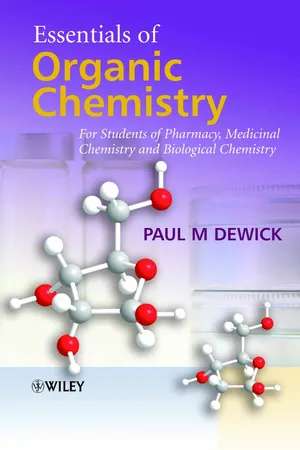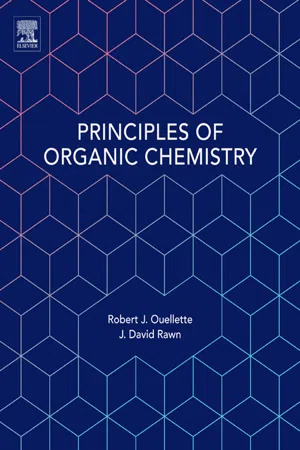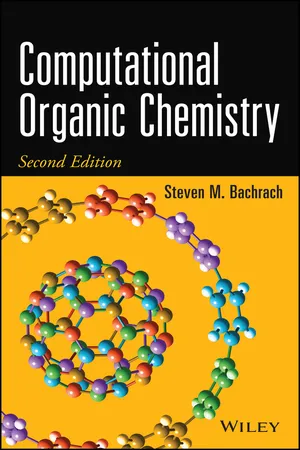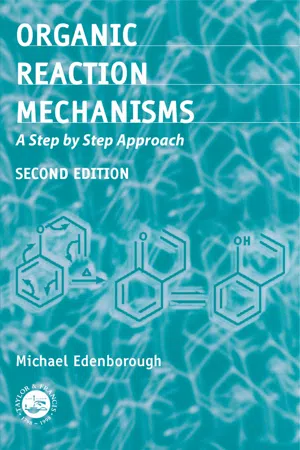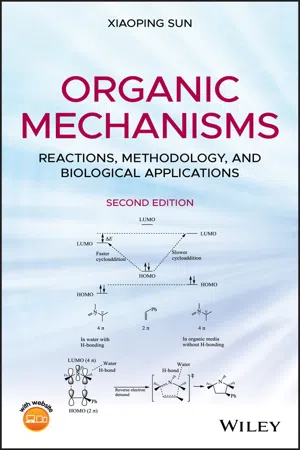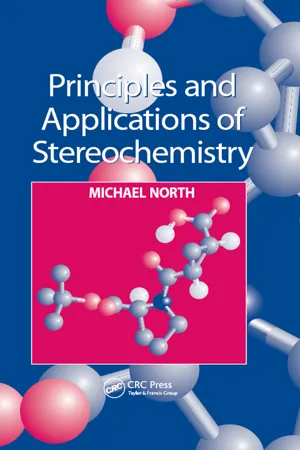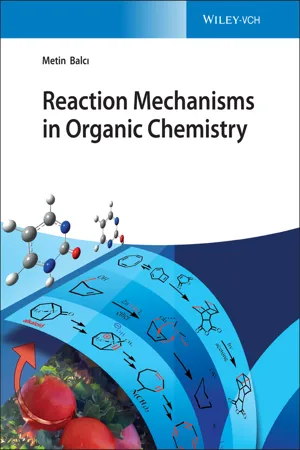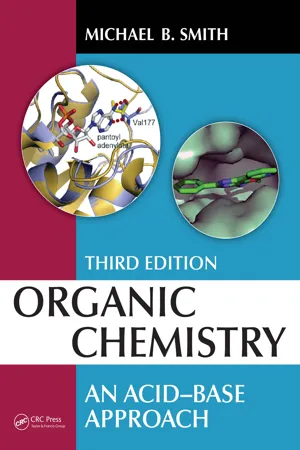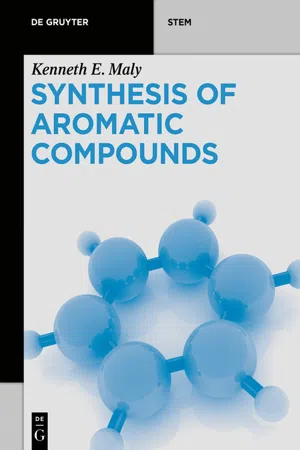Chemistry
SN1 Reaction
The SN1 reaction is a type of nucleophilic substitution reaction in which the rate-determining step involves the formation of a carbocation intermediate. It proceeds in two steps: first, the leaving group departs, forming a carbocation, and then the nucleophile attacks the carbocation to form the substitution product. The reaction is favored in polar protic solvents and with tertiary substrates.
Written by Perlego with AI-assistance
Related key terms
Related key terms
1 of 4
Related key terms
1 of 3
9 Key excerpts on "SN1 Reaction"
- eBook - ePub
Essentials of Organic Chemistry
For Students of Pharmacy, Medicinal Chemistry and Biological Chemistry
- Paul M. Dewick(Author)
- 2013(Publication Date)
- Wiley(Publisher)
Table 6.8 , with secondary substrates being able to participate in either type of process.The most distinguishing feature of the SN 1 mechanism is the intermediate carbocation. Formation of the carbocation is the rate-determining step, and this is more favourable in polar solvents that are able to assist in facilitating the charge separation/ionization. A useful, though not always exact, guide is that SN 1 reactions are going to be favoured by an acidic/positive environment, and are less likely to occur under basic/negative conditions. Since good nucleophiles are often also strong bases, this does tend to limit the applicability of SN 1 reactions. Indeed, under strongly basic conditions, side-reactions such as elimination (see Section 6.4.1) are more likely to occur than nucleophilic substitution reactions. However, all is not lost, because the carbocation is a particularly good electrophile and can be used with relatively poor nucleophiles. This is illustrated in the following examples.Table 6.8 Occurrence of SN 1 or SN 2 reactions according to substrateClass of substrate SN 1 SN 2 Tertiary Common Never Secondary Sometimes Sometimes Primary Never Common Finally, do appreciate that, depending upon conditions, it is quite possible that both SN 1 and SN 2 mechanisms might be operating at the same time, with each contributing its own stereochemical characteristics upon the product.Box 6.4Biological SN 1 reactions involving allylic cationsThe leaving groups most commonly employed in nature are phosphates and diphosphates. These good leaving groups are anions of the strong acids phosphoric (pK a 2.1) and diphosphoric (pK a 1.5) acids respectively. The pK a - eBook - ePub
- Robert J. Ouellette, J. David Rawn(Authors)
- 2015(Publication Date)
- Elsevier(Publisher)
N 2 reaction.When (R) -2-bromobutane reacts with sodium hydroxide, the substitution product is (R) -2-butanol. The reaction occurs with inversion of configuration. Thus, the nucleophile approaches the electrophilic carbon atom from the back and the leaving group simultaneously departs from the front of the substrate in the SN 2 mechanism.The SN 1 Mechanism
A nucleophilic substitution reaction that occurs by an SN 1 mechanism proceeds in two steps. In the first step, the bond between the carbon atom and the leaving group breaks to produce a carbocation and, most commonly, an anionic leaving group. In the second step, the carbocation reacts with the nucleophile to form the substitution product.The formation of a carbocation is the slow, or rate-determining, step. The subsequent step, formation of a bond between the nucleophile and the carbocation, occurs very rapidly. Because the slow step of the reaction involves only the substrate, the reaction is unimolecular. Because only the substrate is present in the transition state, the rate of the reaction depends only on its concentration, and not on the concentration of the nucleophile.Figure 7.3 shows an energy diagram tracing the progress of a reaction that occurs by an SN 1 mechanism. The rate of the reaction reflects the activation energy required to form the carbocation intermediate. The activation energy required for step 2, addition of the nucleophile to the carbocation, is much smaller, so step 2 is very fast. The rate of step 2 has no effect on the overall rate of the reaction.Figure 7.3 Activation Energy and the SN 1 ReactionThe reaction of 2-bromo-2-methylpropane occurs in two steps with formation of an intermediate carbocation. It forms in the rate-determining step, which does not involve the nucleophile. In the second, fast step, the carbocation reacts with a nucleophile such as water to form the product. - eBook - ePub
- Steven M. Bachrach(Author)
- 2014(Publication Date)
- Wiley(Publisher)
N 2 reaction, with emphasis on the gas versus solution phase, is presented first. Next, we describe the critical contribution that computational chemists made in developing the theory of asymmetric induction at carbonyl and vinyl compounds. The chapter concludes with a discussion on the collaborative efforts of synthetic and computational chemists in developing organic catalysts, especially proline and proline-related molecules, for the aldol, Mannich and Michael reaction, and other related reactions.6.1 Substitution Reactions
Nucleophilic substitution reactions are among the first synthetic transformations introduced to beginners learning organic chemistry. The mechanisms for these reactions—SN 1 and SN 2—provide the paradigm for mechanistic understanding of organic reactions. The level of detailed understanding of how nucleophilic substitution occurs in solution is unprecedented, providing the ability to predict regioselectivity and stereoselectivity and relative rates and solvent effects with great accuracy.Most quantum chemical calculations model the gas phase. The SN 1 reaction is essentially unknown in the gas phase. The first step of this mechanism is the heterolytic cleavage of the C–X bond, forming a carbocation and an anionic leaving group. In the gas phase, this separation is strongly opposed by the electrostatic attraction of these two ions, creating a very large barrier. Therefore, this chapter focuses on the SN 2 reaction: the nature of its potential energy surface (PES), the effect of α- and β-branching, and a brief survey of approaches taken toward incorporating solvent into the calculation.6.1.1 The Gas Phase SN 2 Reaction
The mechanism for the gas phase SN 2 reaction is well understood. The extensive experimental studies by Brauman provide the general PES shown in Figure 6.1 .1, 2 The nucleophile and substrate first come together purely by electrostatic attraction to form the entrance ion–dipole complex (ID1). Next, the nucleophile approaches the carbon atom from the backside, pushing out the leaving group, through the classic SN 2 transition state (TS). As the leaving group exits, the exit ion–dipole complex (ID2 - eBook - ePub
Organic Reaction Mechanisms
A Step by Step Approach, Second Edition
- Michael Edenborough(Author)
- 2017(Publication Date)
- CRC Press(Publisher)
SN 2. In this case, the rate of the reaction is observed to be dependent upon both the concentration of the species being substituted, i.e. the substrate, and also upon the incoming nucleophile. The reaction, therefore, is a second order reaction; that is, the sum of the indices of the concentration of the reagents in the rate equation equals two. The order of a reaction is an experimentally observed number and need not be an integer.The mechanism for the SN 2 reaction occurs in only one step, in contrast to the two steps involved in the SN 1 reaction. The incoming nucleophile arrives at the same time as the leaving group departs, i.e. there is simultaneous bond cleavage and bond formation. Any reaction step that involves two molecules is said to have a molecularity of two. The molecularity is a theoretical concept and depends upon the details of the mechanistic step being proposed. By its very nature, it must be a whole number as it represents the number of molecules involved in that step.The rate of an SN 2 reaction may be affected by many different factors, which are similar to those that affect the rate of an SN 1 reaction. These points may be illustrated by examining in detail the approach and simultaneous departure of the incoming nucleophile and leaving group respectively.First, draw a diagram to illustrate the initial approach of a nucleophile, Nuc−, to a general substrate, R3 CX, where X− will eventually become the leaving group. Consider the direction from which the incoming nucleophile will approach.It seems reasonable to suppose that the incoming nucleophile will approach the substrate from a direction that is the opposite to the one in which the C–X bond is to be broken. Thus, the attack is from the opposite side to that from which the leaving group will eventually depart. This ensures that the incoming nucleophile does not interfere with the subsequent departure of the leaving group as the anion, X– - eBook - ePub
Organic Mechanisms
Reactions, Methodology, and Biological Applications
- Xiaoping Sun(Author)
- 2020(Publication Date)
- Wiley(Publisher)
This steric hindrance (characteristic of a tertiary‐butyl group or any tertiary substrate) makes an S N 2 reaction extremely slow (Fig. 6.5). On the other hand, because a tertiary carbocation, such as (CH 3) 3 C +, is relatively stabilized, an S N 1 reaction for a tertiary substrate can take place in a relatively fast rate (Fig. 6.17). In general, the nucleophilic substitution reaction of a tertiary (3°) substrate always follows the S N 1 mechanism. The reaction can be effected by a weak nucleophile (mostly neutral molecules). The type of solvents can change the reaction rate, but does not change the mechanism. For a secondary (2°) substrate such as 2‐halopropane (CH 3) 2 CHX, as the number of methyl groups on the central electrophilic carbon increases, the steric hindrance to the nucleophilic attack from the opposite side of the leaving group is getting more severe. This disfavors an S N 2 reaction, but does not completely prevent it from happening (Fig. 6.5). On the other hand, the stability of a secondary (2°) carbocation allows the S N 1 reaction of a 2° substrate to take place in an appreciable rate (see Fig. 6.17). In addition, a primary substrate which contains an unsaturated group (such as phenyl and vinyl) on the electrophilic carbon can also have both S N 1 and S N 2 reactions. In general, the nucleophilic substitution reactions of a secondary (2°) substrate and a primary (1°) benzylic or allylic substrate can follow either the S N 2 or S N 1 mechanism, depending on the nature of the nucleophile and solvent. Usually, when a reaction is performed with a strong nucleophile (mostly, an anion) in an aprotic solvent, it follows the S N 2 mechanism. If a reaction is performed with a weak nucleophile (mostly, a neutral molecule) in a protic solvent, it follows the S N 1 mechanism. Now, let us look at nucleophilic substitution reactions of (R)‐2‐bromobutane, a secondary haloalkane, performed in different conditions (Fig - eBook - ePub
- Michael North(Author)
- 2017(Publication Date)
- Routledge(Publisher)
molecularity of the reaction, that is the number of molecules which are involved in the rate limiting step of the reaction. The two mechanisms have different stereochemical consequences and each will be discussed in turn.9.2.1 SN 2 reactionsIn an SN 2 reaction, the nucleophile and the electrophile (the species containing the leaving group) are both involved in the rate limiting (and only) step of the mechanism as shown in Scheme 9.2 , giving a bimolecular reaction. Thus the nucleophile (Y_ ) ‘attacks’ the carbon bearing the leaving group (X) at an angle of 180° to the C–X bond, to give in a single step the product via a trigonal bipyramidal transition state. A number of reasons have been proposed to account for the fact that the nucleophile approaches at 180° to the C–X bond. This trajectory minimizes both steric and electronic repulsions between the nucleophile and the four substituents already attached to the carbon atom. Probably more importantly, however, the unoccupied C–X σ* orbital is orientated in this direction as shown in structure9.1.Scheme 9.2During the substitution reaction, an electron pair is donated by the nucleophile to the electrophile as represented by the curly arrow in Scheme 9.2 . These electrons can only be donated into an unoccupied molecular orbital and for energetic reasons this will be the Lowest energy Unoccupied Molecular Orbital (LUMO) which is the σ* orbital of the C–X bond. Similarly for energetic reasons, the electrons will be donated from the Highest energy Occupied Molecular Orbital (HOMO) of the nucleophile. Thus for reaction to occur there must be an interaction between the HOMO of the nucleophile and the LUMO of the electrophile, and it is this that determines the trajectory along which the nucleophile approaches the C–X bond. The orientations and relative energies of the HOMO and LUMOs of chemical species determine the nature of the reactions they undergo. These two orbitals are collectively referred to as frontier orbitals. In both Scheme 9.1 and Scheme 9.2 , the nucleophile has been shown as being negatively charged; this is not necessarily the case, since many neutral species which contain lone pairs of electrons or electrons held in p - eBook - ePub
- Metin Balc?, Metin Balc?, Metin Balc?, Metin Balc?, Metin Balc?(Authors)
- 2021(Publication Date)
- Wiley-VCH(Publisher)
a value is significantly reduced. Then, even a weak base can take the proton, forming a double bond between the carbon atoms bearing the departed groups. As seen from the example above, a common intermediate, a carbocation, is formed in both unimolecular substitution and unimolecular elimination reactions. This cation undergoes substitution or elimination reactions. At this stage, it is important to mention that elimination always competes with substitution.3.1.1 E1 Reaction Mechanism
Remember that the SN 1 reaction proceeds in two steps. The formation of a carbocation is the rate-determining step. Similarly, an E1 reaction also proceeds in two steps, and the rate-determining step is the formation of a carbocation. “E” stands for elimination, while “1” stands for the unimolecular reaction. The carbocation formed must be stable. Furthermore, it is desired to use polar solvents to stabilize the carbocation and to have good leaving groups. Strong nucleophiles attack the carbocation, forming substitution products, while weak nucleophiles form elimination products. Often, both products can occur simultaneously. For example, let us examine the solvolysis of t-butyl bromide in ethanol. Because ethanol is a polar solvent, it both facilitates the removal of bromide and stabilizes the carbocation formed. The t-butyl cation is a common intermediate in E1 and SN 1 reactions. Ethanol attacks the carbocation as a nucleophile and forms the t-butyl ethyl ether. On the other hand, ethanol acts as a base and abstracts a proton from the β-carbon to form an alkene. The nucleophilic substitution product is formed in 81% yield, while the elimination product yield is about 19%.The solvolysis of t-butyl bromide proceeds by the E1 mechanism. The first step is the formation of a carbocation by heterolytic cleavage of the C—Br bond. In the second, a more rapid deprotonation step, ethanol removes a proton from the adjacent β-carbon atom. If there is no proton in the β-position, then the carbocation can either undergo rearrangement or react with a nucleophile. In the case of t - eBook - ePub
Organic Chemistry
An Acid-Base Approach
- Michael B. Smith(Author)
- 2022(Publication Date)
- CRC Press(Publisher)
N 1 reaction can rearrange if the charge can be shifted to an adjacent carbon to give a potentially more stable carbocation. An example is the reaction of 2-chloro-3-methylpentane with KI in aq THF.Rearrangement and SN 1 ReactionsIn the presence of water, ionization of the chloride will give the secondary carbocation, 12, but the final product, 3-iodo-3-methylpentane does not arise from this intermediate. A 1,2-hydride shift gives the more stable tertiary carbocation, 13, which reacts with iodide to give the observed product. Because a carbocation is an intermediate, skeletal rearrangement is a potential issue in any SN 1 reaction. If a primary or secondary cation is generated on a carbon adjacent to a carbon that give a more stable cation rearrangement will occur.- 11.14. Draw the mechanism and the final product formed when (2S)-bromo-2-phenylpentane is treated with KI in aq THF.
Alkyl halides undergo SN 1 reactions to give an alcohol by heating in an aqueous medium. If 2-bromo-2-methylpentane is heated in anhydrous ethanol (no water) for several hours, or for several days there is a reaction and a poor yield of 2-ethoxy-2-methypentane is obtained. This tertiary halide cannot react by an SN 2 mechanism because the activation energy barrier for that transition state is too high. There is no water in this medium, but ethanol is a protic solvent.Although ionization and stabilization of charge (solvation) is not as facile in ethanol as in water (i.e., it is slow), it does occur. Prolonged heating leads to slow ionization of the halide to a tertiary carbocation, which reacts quickly with ethanol to yield an oxonium ion intermediate. Loss of the proton to ethanol in an acid-base reaction yields the ether product, 2-ethoxy-2-methylpentane. Replacement of alkyl halides with solvent in this way is called solvolysis , and it occurs most often with protic solvents (e.g., alcohols). This reaction is a reminder that water is not - eBook - ePub
- Kenneth E. Maly(Author)
- 2022(Publication Date)
- De Gruyter(Publisher)
3 Nucleophilic aromatic substitution reactions3.1 Introduction
In the previous chapter, we saw that aromatic rings themselves are usually nucleophiles, reacting with electrophiles in electrophilic aromatic substitution reactions. Furthermore, SN 2 reactions cannot take place at the sp2 hybridized carbon atoms of an aromatic ring. Nonetheless, as we will see in this chapter, nucleophilic displacements on aromatic rings can occur. We will explore the mechanistic scenarios for nucleophilic aromatic substitution with particular attention to the addition–elimination mechanism. We will also consider the chemistry of aryl diazonium salts, which bear superficial resemblance to nucleophilic aromatic substitution.3.2 Addition–elimination of nucleophiles (SN Ar)
The most common type of nucleophilic aromatic substitution at an aromatic ring proceeds first by nucleophilic addition to the carbon bearing the leaving group to form a delocalized carbanion intermediate, followed by expulsion of the leaving group and rearomatization [1 ]. Because the reaction proceeds by an anionic intermediate, it usually involves electron-deficient aromatic rings. The rate-determining step is typically nucleophilic addition and the reaction usually requires electron withdrawing groups ortho or para to the site of nucleophilic attack (Figure 3.1 ).Figure 3.1: Generalized SN Ar mechanism.As shown in Figure 3.1 , initial nucleophilic attack at the carbon bearing the leaving group results in a delocalized carbanion intermediate, referred to as a Meisenheimer complex. The reaction often requires electron-withdrawing groups ortho or para to the leaving group in order to stabilize the negative charge of the intermediate. The most common electron-withdrawing groups used to activate compounds toward nucleophilic aromatic substitution are nitro groups, but other frequently used groups include cyano, carbonyl, and sulfonate groups. All of these groups can stabilize the negative charge by resonance. This direct resonance stabilization explains the importance of having electron-withdrawing at the ortho- and/or para-positions – groups in the meta-positions can only stabilize the negative charge inductively. As strong support for this mechanism, several Meisenheimer intermediates have been isolated and characterized (Figure 3.2 ) [2
Index pages curate the most relevant extracts from our library of academic textbooks. They’ve been created using an in-house natural language model (NLM), each adding context and meaning to key research topics.
Explore more topic indexes
Explore more topic indexes
1 of 6
Explore more topic indexes
1 of 4
